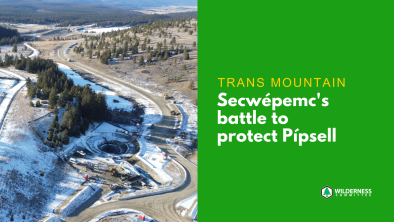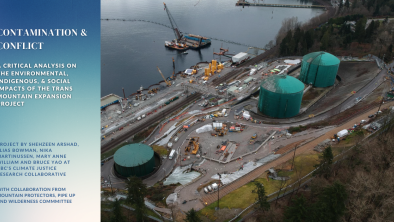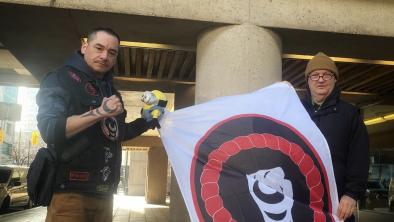Critics flag stricter U.S. rules on LNG tanker risks
Friday, June 12, 2015
Surrey North Delta Leader

A spokesman for a proposed new liquefied natural gas export terminal on the Fraser River insists the industry is safe and critics are trying to "promote fear" by inflating the risks of LNG tankers sailing past populated areas of Delta and Richmond.
Ben Thompson of WesPac Midstream LNG was responding to criticism that the company's proposed Tilbury jetty to serve LNG tankers would face significantly more scrutiny if it were built in the U.S., where a waterway suitability assessment is required.
"I think anybody who questions the safety of LNG maritime traffic is either less than fully informed or has a different agenda," Thompson said, adding LNG tankers are heavily over-engineered.
"In 50 years and over 130 million miles there's never been a major maritime accident with LNG."
The Wilderness Committee has created a risk map of the lower Fraser based on a U.S. Coast Guard document that outlines "zones of concern" in the event an LNG tanker is deliberately ruptured and ignited.
Zone 1, within 500 metres of a ruptured LNG tanker, is "where an LNG spill could pose severe public safety and property hazard and could damage or significantly disrupt critical infrastructure and key assets," according to the U.S. document.
Consequences would be "less severe" in a wider hazard zone band up to 1.6 kilometres away.
Zone 3 would extend up to 3.5 kilometres – which according to the map would encompass all of Steveston and much of Ladner – and is considered the maximum distance a cloud of escaped LNG vapour could drift without dispersing. If it ignited, the cloud could burn back to the tanker and result in a "pool fire."
In all zones of concern, the document says, risk mitigation strategies should be used, refuge areas should be provided, and community education should ensure people know how to react.
However, that U.S. Coast Guard report and an earlier consulting report it relied on were based on the threat of a spill from one of the largest LNG tankers – with a capacity of up to 265,000 cubic metres.
WesPac proposes to use much smaller LNG carriers loaded with no more than 80,000 cubic metres.
Thompson would not discuss differences between U.S. and Canadian regulations, but added he believes the environmental review of the WesPac project will be "rigorous."
The U.S. consulting reports assumed terrorists would succeed in rupturing multiple tanks in an LNG carrier in arriving at their worst-case scenario. They project no spill would result from a grounding or a low-speed collision, and only a small fire with short-range risks flow from a high-speed tanker collision.
The National Energy Board has already granted WesPac a licence to export 3.5 million tonnes of LNG a year by tanker and barge that would be supplied by the adjacent Fortis Tilbury LNG facility.
Ecotrust has argued the 122 mid-sized LNG carriers and 90 more barges per year that would dock at the WesPac jetty could add to cumulative environmental risks for whales and fish habitat.
The Wilderness Committee also accused the federal government of applying a double standard by ignoring risks to the lower Fraser while opposing a U.S. LNG terminal in Maine. Canada's ambassador to the U.S. warned in 2013 it would bring LNG tankers into Canadian waters, creating "environmental, navigational and safety risks" in New Brunswick.
Comment deadline extended
A website glitch has forced federal regulators to extend their June 11 deadline for public comments on whether the proposed WesPac jetty should undergo a federal environmental review and if B.C. should be allowed to substitute its own review process.
The Canadian Environmental Assessment Agency is now taking public comments until June 24.
A website button to email a comment wasn't working and was brought to the CEAA's attention on Wednesday, the second last day of the initial 20-day comment period.
"It was a serious error and the right move on their part to address it," said Kevin Washbrook of the group Voters Taking Action on Climate Change.
He's opposed to the environmental review being performed only by the province, which he says is biased in favour of LNG.
Gas rate impact questioned
Meanwhile, NDP natural gas critic Bruce Ralston questioned if natural gas users may end up subsidizing major LNG-related projects proposed by FortisBC.
The company plans to build a $600-million gas pipeline from Coquitlam to Squamish to feed the proposed Woodfibre LNG plant as well as a $450-million expansion of its Tilbury LNG facility in Delta to supply the tankers that would dock at WesPac.
The province exempted those projects from review by the B.C. Utilities Commission and Ralston said that means FortisBC can add the costs to the rates paid by existing customers. "I question whether it's in the best interests of rate payers."
Energy ministry spokesman David Haslam said residential gas users won't be charged for the LNG projects, adding a natural gas tariff on LNG proponents like Woodfibre will cover all the costs.
He said the province exempted the LNG related projects from BCUC requirements to give FortisBC business certainty in planning them.
FortisBC vice-president Douglas Stout said gas infrastructure upgrades paid for by new LNG exporters will actually result in lower natural gas delivery rates for all natural gas customers.
Photo: B.C. environmental groups circulated this map to show how U.S. Coast Guard-defined hazard zones for LNG tankers would overlay the route from the proposed Tilbury LNG jetty. Red, purple and blue indicate the 500 metre, 1.6 kilometre and 3.5 kilometre zones, respectively.


